#Advantage of Flutter App Development
Explore tagged Tumblr posts
Text
7 Tips That Take Advantage Of Flutter App Development
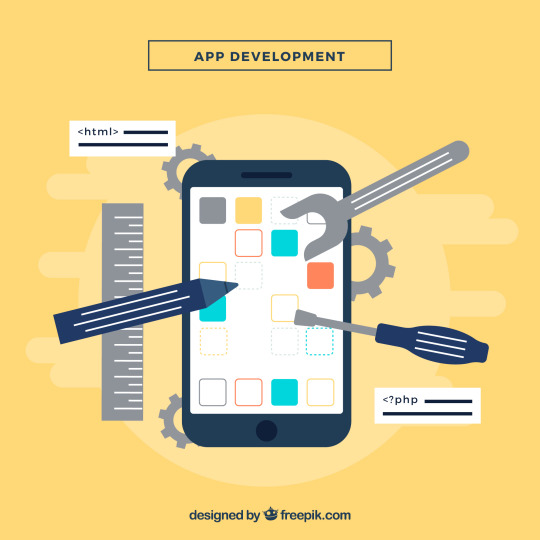
In the ever-evolving world of mobile app development, Flutter has emerged as a game-changing framework, making it easy for developers to create high-quality apps that run seamlessly across both iOS and Android platforms. Flutter’s unique approach to cross-platform development is revolutionizing the way apps are built by delivering a rich user experience with impressive performance. If you’re looking to leverage Flutter to its full potential, here are seven key tips to help you to get the most out of this powerful toolkit.
Understand Flutter's Core Principles
Before diving into Flutter app development, it's essential to understand the core principles that make this framework stand out. Flutter allows developers to write a single codebase that works across both iOS and Android. Its widget-based architecture makes designing flexible user interfaces a breeze and with the Dart programming language at its core, it ensures high performance and minimal delay.
By taking the time to familiarize yourself with the fundamentals of Flutter, such as its widget system, the Dart language and how Flutter's rendering engine works, you'll be better equipped to design and develop robust apps that take advantage of the framework’s full potential.
Use Widgets for Flexible UI Design
One of the main advantages of Flutter is its rich set of pre-built widgets. These widgets allow developers to create highly customizable UIs that can be tailored to meet specific user needs. From simple buttons to complex layouts, Flutter's widget-based system allows for maximum flexibility while maintaining performance.
To maximize the potential of Flutter, embrace custom widgets that meet your app’s unique design requirements. With Flutter's composition model, you can easily combine and nest widgets to create intricate designs that feel native to both iOS and Android, without compromising performance.
Optimize for Performance with Flutter's Hot Reload
Flutter’s hot reload feature is one of its most talked-about capabilities and for a good reason. It allows developers to instantly see the changes made in the code on the emulator or real device without having to restart the entire app. This feature speeds up the development process and allows for more frequent iterations during the development phase.
Take full advantage of hot reload by making frequent updates and fine-tuning your app’s features as you go. It’s perfect for testing out UI changes, experimenting with new ideas and speeding up the overall development process. Dignizant technologies is the best flutter app development company in India, it offers the world’s best IT services and also provides ongoing support.
Integrate Native Features Using Platform Channels
Even though Flutter allows you to create cross-platform apps with a single codebase, sometimes you’ll need to access platform-specific functionality. Flutter makes this easy with Platform Channels, which allow you to write custom code in Kotlin, Java, Swift or Objective-C when needed. This means that even though you’re using a single codebase, you can still take advantage of the unique capabilities of each platform.
For example, if you need to integrate Bluetooth, device sensors or other hardware-specific features, you can use Flutter’s Platform Channels to write native code and connect it to your Flutter app seamlessly.
Leverage Flutter’s Rich Ecosystem of Plugins
Flutter’s ecosystem is home to thousands of community-driven plugins that can help you quickly implement features like camera access, geolocation, push notifications and more. These plugins, available on Flutter’s package repository, save time and effort, allowing you to integrate third-party services and tools without reinventing the wheel.
When developing your app, always check if there’s an existing plugin that can provide the functionality you need. This will not only speed up development but also ensure that your app leverages tried-and-tested solutions.
Test Your App on Multiple Devices
Cross-platform development is one of Flutter’s biggest advantages, but it’s important to remember that iOS and Android devices come in many shapes and sizes. Flutter allows you to preview your app on different screen resolutions and orientations, but testing on real devices is crucial to ensure a flawless user experience.
To take full advantage of Flutter, make sure to test your app thoroughly on a range of devices. Flutter's flutter drive command can help to automate integration testing and check that your app works seamlessly across multiple platforms.
Stay Up-to-Date with Flutter's Continuous Improvements
Flutter is constantly evolving, with Google regularly releasing new updates, improvements and bug fixes. To keep your app in top shape and take advantage of the latest features, always stay up-to-date with the latest version of Flutter.
By keeping track of updates and adopting new features as they become available, you can ensure that your app remains modern, performant and compatible with the latest devices and operating systems. Whether it’s new widgets, performance improvements or updates to the Flutter engine, these updates often come with enhancements that can improve the overall user experience of your app.
Conclusion
In conclusion, Flutter app development offers a powerful and efficient way to build high-quality apps for both iOS and Android platforms. By understanding its core principles, utilizing its flexible widget system and taking advantage of features like hot reload and platform channels, developers can optimize their app development process. With a rich ecosystem of plugins and access to continuous updates, Flutter enables developers to create exceptional, cross-platform apps that stand out in the market.
#Flutter App Development Company In India#Flutter Application Development Company in India#Best Flutter App Development Company in India#Flutter Mobile App Development Company in India#Flutter App Development Company India#Top Flutter App Development Company in India#Flutter App Development Companies in India#Flutter App Development Services In India#Best Flutter App Development Companies in India#Top Flutter App Development Companies in India#Best Flutter App Development Company#Best Flutter App Development Agency#Best Flutter App Development Services#Advantage of Flutter App Development
0 notes
Text
FlutterFlow: The Right Platform to Embark Your Startup Journey
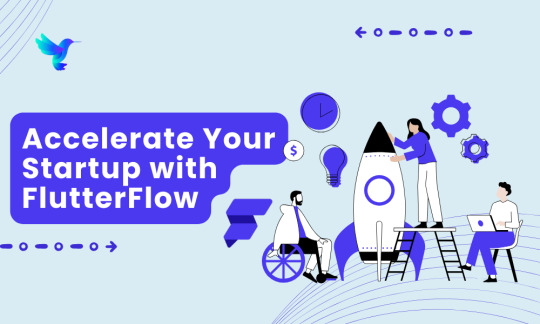
In the cut-throat competitive landscape of businesses, time to market, technology used, and profits generated are the cornerstones of defining success. The capability to implement advanced technology to innovate your business application and execute it successfully gives you a competitive edge. Traditional app development, with its daunting coding requirements and long timelines, often poses challenges for startups with an extended time to market.
Enters, low-code platforms that offer a simple solution to accelerate development without compromising on development quality. One of such platforms gaining popularity is, FlutterFlow.
Let’s explore why FlutterFlow is loved by so many startups and what it brings to the table. Before we get into the nitty-gritty of FlutterFlow, let’s dig in a little deeper to understand low-code development.
What Is Low Code Development?
Low code development refers to software development environments that let developers build applications through graphical user interfaces rather than traditional codes. The platforms reduce the amount of manual coding, which results in faster development lifecycles and easier iterations.
Benefits Of Low-Code Platforms
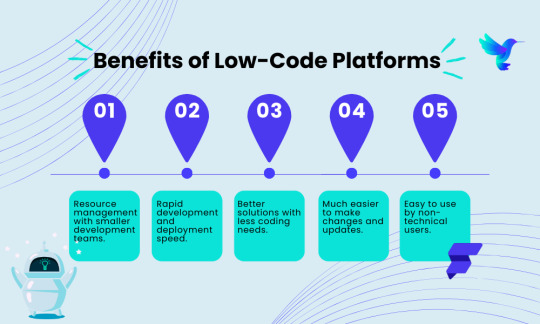
Rapid development and deployment speed.
Resource management with smaller development teams.
Better solutions with less coding needs
Easy to use by non-technical users, making it easier for them to contribute to the app development process.
Much easier to make changes and updates.
Thus with the ease and accessibility to even non-technical users, Low Code development is helping startups create professional applications on a budget. Some of the popular low-code platforms are Appian, Creatio, Outsystems, FlutterFlow, etc.
FlutterFlow gets a lead over others as it is taking low code development to new heights. Let’s now explore what makes FlutterFlow a perfect platform for your startup.
What is FlutterFlow?
FlutterFlow is built on Google’s Flutter framework, designed for developing cross-platform applications for Android, iOS, and the web. It offers a visual design interface, allowing users to plan app layouts effortlessly through simple drag-and-drop capability. FlutterFlow helps real-time collaboration, making it best for teams working together on a development project.
With an easy-to-use interface, no technical skills, and a strong framework to back it, FlutterFlow has been gaining popularity since it was conceived. Whether you are a startup or a small-scale business, if you want to create a mobile application that resonates with your audience, then, choose the FlutterFlow platform and let things flow.
Why FlutterFlow Is Perfect for Startups?
FlutterFlow is taking low code development to new heights by offering a visual development environment where users can build the solutions they want without compromising on app feature quality.
FlutterFlow basically incorporates and promotes best practices for software development. The platform streamlines complex IDE tasks into an intuitive UI, making developer interactions easier. To use the platform one needs basic training, thus even non-developers get into the basics of core app development concepts.
FlutterFlow entered the market with a vision to go from low code development to visual development. Here’s how the team is planning to achieve their goals:
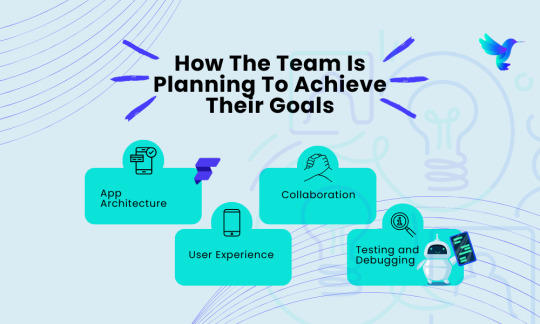
App Architecture: The codes generated using FlutterFlow meet the standards set by Flutter and Dart. They abide by the standard app market, thus helping users with a credible app development solution.
Testing and Debugging: The developers can simply test and debug the applications by running, testing, and resolving issues. This allows startups to enter the market with a flawless and highly rewarding application.
Collaboration: With modular development, smart version controls, and comprehensive access management, users can collaborate easily for better results.
User Experience: With an easy-to-explore interface, edit on clicks, ensure consistency, incorporate AI where possible, and users can switch between code and GUI.
FlutterFlow offers startups an environment where they can cross-operate, collaborate, and discuss their problems. The platform is conceived to make development easier, more convenient, and accessible for non-tech people also, who can easily make their contribution to the web now!
Some of the other advantages of the platform are:
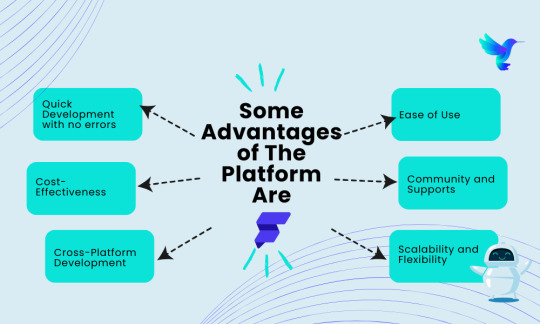
1. Quick Development With No Errors
The cheat code to making the best of your business is, to enter the market ASAP.
One of the most significant benefits of FlutterFlow is the speed at which the projects may develop. The platform’s visual interface and pre-built elements allow for speedy prototyping and development. Startups can fast-build minimum viable products (MVPs) to check thoughts in the marketplace without making a heavy investment in development sources.
Thus, you can create a product faster, take it to the market, and get feedback easily. We understand not every product works well on the first go, but with FlutterFlow you get the ease of making iterations and offering your audience a solution they’d appreciate.
2. Cost-Effectiveness
Most startups run on budget constraints. FlutterFlow helps reduce investing in large teams of seasoned developers. The platform’s drag-and-drop capability and pre-built templates lessen the quantity of custom code required, which translates to lower support and maintenance fees. A developer with lesser experience and understanding of the development languages can also, easily create an app here making it easier for you to invest your funds in other business verticals too.
3. Cross-Platform Development
FlutterFlow’s foundation lies at the Flutter framework which guarantees that applications are cross-platform by default. Thus by picking FlutterFlow startups can create and deploy applications to iOS, Android, and net platforms simultaneously. This cross-platform functionality is crucial for startups looking to maximize their target audience and digital presence without incurring the expenses and complexities of keeping separate codebases for specific platforms.
4. Ease Of Use
FlutterFlow is designed to be user-friendly, making it accessible to both skilled app developers and those with limited coding exposure. This democratization of app development means that non-technical founders and team members can contribute to the development procedure. FlutterFlow also gives tremendous documentation and tutorials, further decreasing the barrier to entry.
Because it is easy to use, the startup founders can make changes to the product as they want.
5. Scalability And Flexibility
Despite being a low-code platform, FlutterFlow gives massive flexibility. Users can add custom code to increase the functionality of their programs, making sure that they are now not confined with the aid of the platform’s built-in features. FlutterFlow additionally integrates seamlessly with backend services like Firebase and Supabase, bearing in mind robust and scalable backend solutions.
6. Community And Support
Being part of the Flutter ecosystem, FlutterFlow advantages from an active and supportive community. This network affords a wealth of assets, tutorials, and discussions that could assist startups conquer challenges and make the most of the platform. Additionally, FlutterFlow is continually evolving, with new capabilities and improvements being brought often based on user comments.
New users can always connect with the community for any assistance and customization thus creating a growth-oriented and learning ecosystem.
These are some of the most popular reasons why FlutterFlow is one of the most prominent low-code platforms for startups. So, if you are aiming to start your entrepreneurial journey and aren’t sure how to start without investing much in development, FlutterFlow is your trusted development partner.
Addressing Common Concerns of Using FlutterFlow
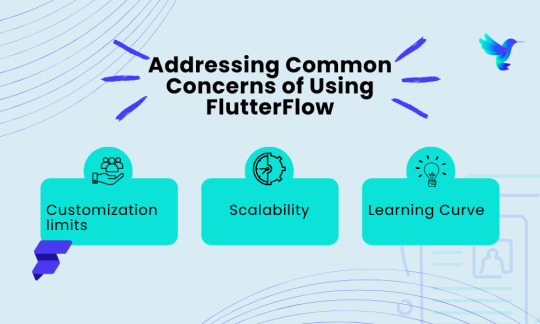
FlutterFlow may offer a great advantage for startups and businesses, but it does come with some limitations. Let’s explore the common concerns when working on the platform.
Customization Limits
The most common and often-faced concern with low-code platforms is the potential difficulty of customization. However, FlutterFlow mitigates this with the aid of custom code integration. This ensures that whilst you can enjoy the speed and efficiency of low-code development, you still have the flexibility to put into effect custom functions as wanted.
Scalability
Another concern is scalability. FlutterFlow is designed to handle significant user load and great data volumes through its integration with a powerful backend. Startups can hopefully scale their packages as their customer base expands, knowing that the platform is designed and developed to meet their business needs.
Startups with a limited user base can use the capabilities of FlutterFlow for future preparedness.
Learning Curve
While FlutterFlow is user-friendly, there can still be a strong learning curve, specifically for those new to app development. However, the considerable assets available, together with documentation, tutorials, and network help, assist mitigate this challenge.
Startups can always seek assistance from other development agencies experienced in FlutterFlow to boost learning and make sure first-class practices are followed. With little time and dedication, one can excel in their skills and implement them to build innovative products for the future.
Conclusion
FlutterFlow represents a tremendous advancement in the realm of low-code development systems, particularly for startups. Its combination of speed, value-effectiveness, ease of use, and flexibility makes it a super choice for early-stage businesses seeking to deliver their thoughts to the marketplace. By leveraging FlutterFlow, startups can reduce development time and fees, build cross-platform applications, and remain agile in a competitive landscape.
For startups and small-scale organizations trying to maximize their assets and boost their development process, FlutterFlow offers a compelling solution that bridges the gap between rapid prototyping and strong, scalable app development. As the platform continues to evolve and improve, it’s far poised to end up a good extra effective device for startups aiming to innovate and be triumphant in the virtual age.
#FlutterFlow#Custom App Development#FlutterFlow Startup businesses#Challenges for startups businesses#Low Code Development#graphical user interfaces#Benefits Of Low-Code Platforms#Google’s Flutter framework#cross-platform applications#Hire Flutter Developers#software development#advantage for startups and businesses
0 notes
Text
How Flutter’s Features Enhance Your App: 7 Key Benefits
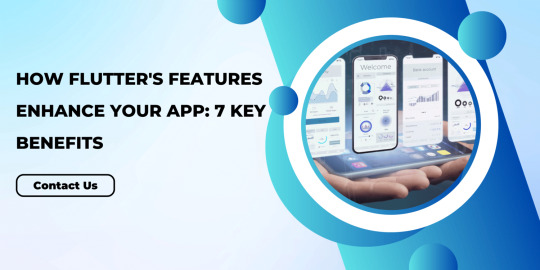
Nowadays In the digital world, developing an app that stands out is crucial. One tool that’s been gaining significant attention is Flutter. But what makes Flutter so special? Let’s dive into how Flutter’s features can enhance your app, highlighting seven key benefits that can make a difference.
1. Single Codebase Advantage
One of the standout features of Flutter is its single codebase advantage. Imagine being able to write your app’s code once and have it run smoothly on both iOS and Android platforms. This is not just a dream; it’s a reality with Flutter. This saves a tremendous amount of time and effort, allowing developers to focus more on enhancing the app rather than rewriting code for different platforms.
2. Fast Development with Hot Reload
Have you ever wished for a magic wand that could instantly show the results of your code changes? Flutter’s hot reload feature is just that magic wand. This feature lets developers instantly view their changes without the need to restart the entire application. This speeds up the development process significantly, making debugging and UI tweaks a breeze.
3. Beautiful, Customizable UI
Flutter is known for its ability to create stunning and highly customizable user interfaces. With a rich set of pre-designed widgets and the flexibility to create custom ones, Flutter ensures that your app doesn’t just perform well but also looks amazing. The layered architecture of Flutter allows for full customization, right from the design to the behavior of each widget.
4. High Performance
Performance is a critical aspect of any app. Flutter applications are renowned for their high performance because they are compiled directly into native ARM code. This ensures that the app runs smoothly and efficiently, offering users a seamless experience. Whether it’s handling complex animations or rendering multiple elements on the screen, Flutter ensures everything works flawlessly.
5. Strong Community Support
No developer is an island. The strength of a development tool often lies in the community behind it, and Flutter boasts a vibrant and supportive community. From extensive documentation to numerous forums and user groups, you’ll find a wealth of resources and support. This makes troubleshooting and finding best practices easier, ensuring your app development journey is smooth and supported.
6. Rich Set of Widgets
Widgets form the core components of any Flutter app. Flutter comes with a rich set of pre-designed widgets that cater to almost every need. Whether you need simple buttons and sliders or more complex elements like grids and lists, Flutter has you covered. These widgets are not only functional but also customizable, allowing you to tailor them to your app’s specific requirements.
7. Cost-Effectiveness
Developing an app can be expensive, but Flutter helps in reducing costs significantly. By allowing a single codebase to be used across multiple platforms, development time and resources are saved. Moreover, the lower maintenance costs and the availability of free resources from the Flutter community contribute to overall cost savings. For startups and small businesses, this cost-effectiveness is a game-changer.
Conclusion
In conclusion, Flutter app development offers numerous benefits that can greatly enhance your app. From its single codebase and fast development process to its beautiful UI and high performance, Flutter provides a comprehensive solution for building cross-platform apps. The strong community support, rich set of widgets, and cost-effectiveness further add to its appeal, making Flutter an ideal choice for app developers.
FAQs
What is the main advantage of using Flutter for app development?
The main advantage of using Flutter is its single codebase that works across both iOS and Android platforms, saving time and resources.
How does Flutter’s hot reload feature benefit developers?
Flutter’s hot reload feature allows developers to view updates instantly without restarting the application, significantly speeding up the development process.
Can Flutter create high-performance apps?
Yes, Flutter compiles directly to native ARM code, ensuring high performance and smooth user experiences.
Is Flutter suitable for small businesses and startups?
Absolutely. Flutter’s cost-effectiveness, due to its single codebase and lower maintenance costs, makes it ideal for small businesses and startups.
Where can I access support and resources for Flutter development?
Flutter has a strong community with extensive documentation, forums, and user groups where you can find support and resources for your development needs
#Flutter App Benefits#Enhance Your App with Flutter#Key Features of Flutter#Flutter Development Advantages#Boost App Performance with Flutter#Why Choose Flutter for Apps#Flutter for Mobile Development#Top Flutter Features#Flutter App Enhancement#Benefits of Using Flutter
0 notes
Text
In 2024, Savvient Technologies advocates for Flutter, citing its rapid development, seamless cross-platform compatibility, and rich widget set. Embrace Flutter for cost-effective, high-performance app development with streamlined maintenance, revolutionizing your mobile experience.
1 note
·
View note
Text
Here We mentioned all Pros and cons for Flutter App Development. Click here to know in details.
1 note
·
View note
Text
Exploring the Difference Between Web Development and App Development
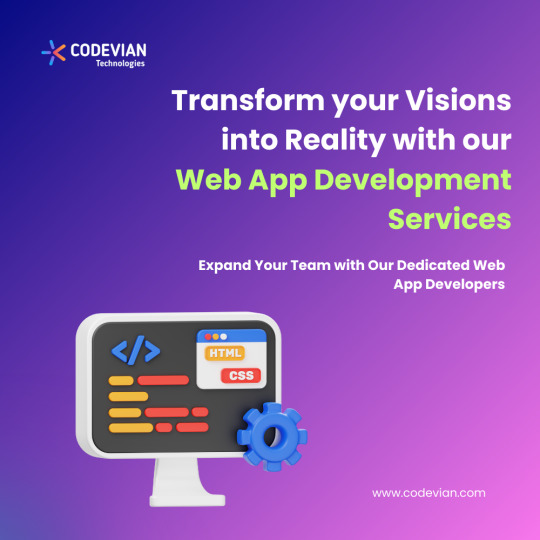
Hey there, tech enthusiasts! So, you've heard about web development and app development, but you're not quite sure what sets them apart? Don't worry, I'll break it down for you in simple terms!
First things first, what exactly is web development? Well, think of it like building a house on the internet! Web development involves creating websites or web applications that can be accessed through a web browser, like Google Chrome or Safari. It's all about designing, building, and maintaining websites that people can visit and interact with online.
Now, let's talk about app development. This is like building a cozy little home on your smartphone or tablet! App development involves creating mobile applications that are installed directly onto your device, like games, social media apps, or productivity tools. It's all about designing, building, and maintaining applications that people can download and use on their mobile devices.
So, what's the difference between web development and app development? Here are a few key distinctions:
Platform: The biggest difference between web development and app development is the platform they're built for. Web app development services focuses on creating websites or web applications that are accessed through a web browser on desktop computers or mobile devices. App development, on the other hand, focuses on creating mobile applications that are installed directly onto a device and accessed through an icon on the home screen.
Technology: Web development typically involves technologies like HTML, CSS, and JavaScript for creating the front end (what users see and interact with) and languages like PHP, Python, or Node.js for creating the back end (the server-side logic). App development, on the other hand, often involves languages like Java or Kotlin for Android development, Swift or Objective-C for iOS development, or frameworks like React Native or Flutter for cross-platform development.
Distribution: Web applications are usually accessible to anyone with an internet connection and can be accessed through a web browser without the need for installation. Mobile applications, on the other hand, need to be downloaded and installed onto a device from an app store like the Apple App Store or Google Play Store.
User Experience: The user experience of web applications and mobile applications can be quite different. Web applications are designed to work across different devices and screen sizes, so they often have a responsive design that adapts to fit the user's device. Mobile applications, on the other hand, are specifically designed for use on mobile devices and can take advantage of features like touch screens, GPS, and push notifications.
In conclusion, while web development and app development share some similarities, such as creating digital experiences for users, they also have key differences in terms of platform, technology, distribution, and user experience. Whether you're interested in building websites or mobile applications, both fields offer exciting opportunities to unleash your creativity and make an impact in the digital world!
2 notes
·
View notes
Text
woops.
volkan şahin | i̇lhan şen fc.
ceo / apps developer. thirty five. cis man. he / him. bisexual.
intelligent, booksmart man, who is dangerously stupid when it comes to love. wears his heart on his sleeve, hopeless romantic. could easily get conned by a woman who merely started a conversation with him and fluttered her eyes. developed several different apps that have taken off, he's willing to sell them off despite the money he's been offered. they're his babies, after all. perpetual bachelor, looking for the one. unlikely he'll meet them since he's constantly locked away in his office.
aslan şengöz | can yaman fc.
carpenter / artist. thirty three. cis man. he / him. bisexual.
creative man who's very good with his hands. works for himself and wouldn't have it any other way. is incredibly good at what he does, is able to make a castle out of a few pieces of wood. often underestimated, yet incredibly streetwise. doesn't really date often. had a long-term relationship since fifteen and recently found out she'd been cheating on him with somebody else. wary of relationships, enjoys a decent hook-up. is fiery and easily rattled, but has a heart of gold.
rasim gören | aytaç şaşmaz fc.
football player. twenty five. cis man. he / him. bisexual.
passionate man who's incredibly good at everything he puts his mind to. tries to hide how hard he's had to work to get where he has, though who knows why. sports have always been his life, never saw himself in any other world. he's known as a lothario, but in reality he's a bit of a baby really. he gets on with women better than men most of the time, and the majority of the women he's 'spotted' with are more likely to be like sisters to him than conquests. he talks a big game, but he's full of it.
yusuf payan | serkan çayoğlu fc.
public relations manager. thirty five. cis man. he / him. bisexual.
appears to be the most grumpy man alive, and he very well might be. finds his job fulfilling yet often exhausting. sometimes he's pretty ure he's working with children, but at least they keep him on his toes. no day is the same and it's never dull -- but he very may well be sent to an early grave because of the stress that he's often drowning in. means well, but can be alittle intimidating. uses that to his advantage when telling off his clients. disappointed dad friend.
dallas ockerman | jon bernthal fc.
ice hockey coach. forty six. cis man. he / him. bisexual.
may look terrifying and intimidating, but is actually a golden retriever. spends his downtime with his sister and her girlfriends and loves a good face mask to end a stressful day. is an uncle and takes that very seriously. a hopeless romantic who loves sex when it has feelings. has more women as friends than he has men. they can be so annoying sometimes, after all. he's very selfless and will put whoever he's with first. spoil them rotten. believes it's too late for him now to ever meet the one.
margot dupont | lily sullivan fc.
music technician. twenty eight. cis woman. she / her. bisexual (preference for women).
intelligent and beautiful woman. who uses her beauty and intellect to her advantage. 'one of the boys' though she's never been particularly proud of that title. girls girl and opinionated without remorse. loves to let everyone know what she thinks. enjoys her job a lot and loves to travel. constantly taking photographs of herself, her surroundings and those she loves. believes that memories matter. is a little irresponsible but knows it and is working on it...which is the main thing.
annie jackson | lily sullivan fc.
personal trainer / painter. thirty. cis woman. she / her. lesbian.
perpetually single and exhausted by it. wine lover and cat mum. never had a good, long and lasting relationship. would really love that to change. she's on every dating app imaginable, but she'd never confess that to her brothers. finds most events exhausting and deals with 'hangxiety' but will never stop partying. loves her family, but envies them in equal measure. is incredibly flexible and good at her job. paints on the side, has sold a few pieces. loves life - she just wishes she had someone to enjoy it with.
owen teller | mitch marner fc.
ice hockey player. twenty four. cis man. he / him. bisexual.
grew up on an estate, with parents who believed he could achieve greatness. as a sister that is basically the same age as him -- and he's deathly protective of her. they were both given the best starts their parents could offer them, who saved every penny in order for them to both achieve their dreams. he's a bit of a 'chav', never seen out of a tracksuit of some sort. he's a nice guy though, often helps little, old ladies across the street. enjoys getting high when that's possible, doesn't like drama.
ethan sutcliffe | finn cole fc.
teaching assistant. twenty seven. cis man. he / him. bisexual. kip's younger brother.
the kids in his class loves him and he's very passionate about his job. knows how to take initiative and spends his evenings learning what they need to learn, so he can help them to the best of his ability. the teacher he works with (lucas) is one of his best friends and they do spend time outside of school together. all in all, he's a soft touch, but he can be stern when he really needs to be. enjoys pub nights and bottomless brunches. knows how to fun and never fails to do so. is a little intimidating at points and was the popular sports boy at school. grew out of most of his silly behaviours, though.
kieran 'kip' sutcliffe | taron egerton fc.
primary school teacher. thirty one. cis man. he / him. bisexual (preference for women). ethan's older brother.
one of two male teachers in his school, and boy does he use that to his advantage. total flirt and shameless about it. loves his job and is so passionate in all that he does. his brother calls him 'cbeebies' on account of the child-like way he approaches teaching, putting every inch of excitment he pocesses into almost every lesson. pe lead. and bit sports fan. nanna's boy through and through. was told he'd never amount to nothing at school, yet look at him now. has a soft spot for all the 'naughty' kids in his class and tries his best to help them out when he can see they need that. thoughtful and cheeky and awfully charming, the man is the best sort of friend you can possibly have, even if he's definitely going to flirt with you, too.
4 notes
·
View notes
Text
What is the Best Mobile Application Development Framework, Flutter, or React Native?
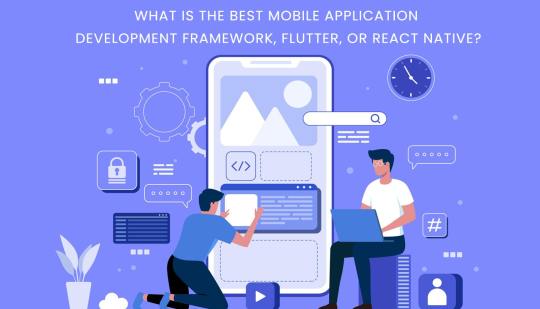
As an ever-increasing number of individuals are accepting modernized innovation in technology, the interest in mobile applications has expanded step by step.
Hybrid mobile frameworks are acquiring prevalence. The presence of React Native (RN) in 2015 opened astounding chances to assemble applications for iOS and Android utilizing one codebase. Thus, it permitted us to solve two problems at once and not rework a similar code two times. Large firms like UberEats, Discord, and Facebook moved to React Native, a powerful promotion.
Google didn’t stand separated; they saw the immense popularity of RN. Subsequently, Google presented an alpha version of its hybrid framework called Flutter in 2017. Flutter likewise turned into an extremely famous framework. The improvement of a framework like React Native prompts confusion over what to decide for hybrid mobile app development:
React Native or Flutter? Nonetheless, there’s another significant inquiry which you ought to choose before this: Is it better to develop a hybrid or native mobile apps?
Both cross- platform application has its upsides and downsides and prevalence
Flutter
Flutter is an open-source mobile application development Software tool sh that has design & created by Google. It had its main release in May 2017. Flutter has composed into the C, C++, Dart, and Skia Graphics Engine. Flags have been created by Google. Creating Android and Android applications is additionally utilized. The SDK is free and sent off as a source designer to explore and make strong, powerful applications around.
Why choose to Flutter for Android and iOS mobile application development?
Cross-platform
Hot Reload
High compatibility with programming languages
Faster and improved native performance
Appealing UI
Accessible SDKs and native features
The functional and reactive framework
React Native
React Native is a structural framework made by Facebook that permits us to foster local mobile applications for iOS and Android with a solitary JavaScript codebase.
React native is a genuine mobile application, additionally open-source application development system which is created by Facebook. Rouse that ideas should be created on the web for mobile development. Reactive native is accustomed to making iOS and Android applications. IT was delivered in March 2015. In such a manner, JavaScript is created. Notwithstanding, the application appearance is by all accounts a native app.
Why choose to React Native forAndroid and iOS app development?
Seamless and synchronous API
Seamless and synchronous API
Quick performance
Greater reach
Which is Better: Flutter or React Native?
Flutter ranks positions higher with 75.4% and React Native likewise cut with 62.5% among most cherished frameworks.
Both Flutter and React Native are famous and exceptionally used by the application developers for the development of cross-platform applications. Every single one of them has their one-of-a-kind upsides and downsides, stability in development, speed, and much more.
Flutter is a new framework, and it is expanding and growing slowly and gradually. Compared to Flutter, React Native is in the industry for a long time now. Hence, it is mature enough that leading brands have experienced its benefits of it. While Flutter is yet to have such strong case studies.
The choice of the right framework can be best done based on your mobile app requirements.
Flutter is new in the framework market, and it is extending and developing gradually and slowly. Contrasted with Flutter, React Native is in the business for quite a while now. Thus, mature an adequate number of leading brands have encountered its advantages of it. While Flutter is yet to have areas of strength for such investigations study.
#marketing#socialmediamarketing#digitalmarketing#branding#contentstrategy#jexcore#marketingagency#marketingdigital#marketingservices#digital marketing
2 notes
·
View notes
Text
How XcelTec Can Help With Best Flutter App Development Services?

Cross-platform app development tool Flutter helps developers balance productivity and quality. Applications developed for mobile platforms using Flutter provide a number of benefits and accelerate application development. A few key components in the development of Flutter applications are listed below:
Single-Based Coding
Broad Widget Library
Upgraded User Experience
Material Design and Cupertino
Dart Advantages
Best Flutter App Development Services by XcelTec;
As the leading provider of Flutter app development services, XcelTec offers a range of Flutter App Development offerings that have aided clients all over the world in reaching the zenith of their development. Our unrivalled and incredibly dependable Flutter application engineers assist companies in creating cross-platform native interfaces of the highest calibre.
We fully utilise the advancing technology to provide a WOW experience. Additionally, we promise that the most skilled Flutter developers will support your application with the best work available in the industry. To have a lasting impact on our knowledgeable, existing clients, we provide a unique range of Flutter app development features, which include:
UI/UX Design
Dart App Development
Flutter Development for iOS and Android
Front-end and Backend Development
Flutter Cross-platform Development
Testing and QA Solutions
Application Migration and support
Visit to explore more on How XcelTec Can Help You With The Best Flutter App Development Services?
Get in touch with us for more!
Contact us on:- +91 987 979 9459 | +1 919 400 9200
Email us at:- [email protected]
#flutter app development#flutter app development company#flutter app#flutter development#flutter development services#hire mobile app developer
2 notes
·
View notes
Text
What is flutter
Flutter is a free, open-source software development kit created by Google that allows developers to create beautiful, high-performance mobile apps for both Android and iOS platforms with a single codebase. With Flutter, developers can write code once and deploy it to multiple platforms, reducing development time and costs.
One of the most significant benefits of Flutter is its ability to create highly customized and visually stunning apps. Flutter provides a rich set of pre-built widgets, which allows developers to build beautiful user interfaces quickly. Additionally, developers can create custom widgets and animations using the Flutter framework, which makes it easy to create highly personalized user experiences.
Another significant advantage of Flutter is its performance. Flutter apps are typically faster than traditional mobile apps because they are built using Dart, a language that compiles to native machine code. This means that the apps run natively on the device, rather than relying on a browser or interpreter to display the app.
Flutter also provides developers with hot reloading, which allows them to see changes in the app's code instantly. This feature makes it easier for developers to iterate and test their apps quickly, reducing development time.
In addition to mobile app development, Flutter is also being used to build desktop and web applications. Google has been working on expanding the Flutter platform to other form factors, and in 2021 they announced that they are working on a new project called "Flutter for web," which allows developers to build web apps using Flutter.
In conclusion, Flutter is a powerful and versatile tool for building beautiful, high-performance mobile, desktop, and web applications. With its rich set of pre-built widgets, customizability, and performance, Flutter is quickly becoming one of the most popular choices for mobile app development. As the platform continues to evolve, we can expect to see even more exciting developments from the Flutter community in the years to come.
2 notes
·
View notes
Text
Here is our insight on Flutter App Development Cost, Why Flutter is important for mobile app development. Know more in details, visit here.
1 note
·
View note
Text
Software Development Services in Delhi: Transforming Businesses with Technology

businesses across industries are leveraging software solutions to streamline operations, enhance customer experiences, and drive innovation. Delhi, as a thriving hub for technology and commerce, is home to numerous software development companies that offer a wide range of services tailored to various business needs. From software development services in delhicustom software solutions to enterprise applications, software development services in Delhi cater to startups, SMEs, and large enterprises, ensuring robust digital transformation.
Understanding Software Development Services
Software development services encompass designing, developing, deploying, and maintaining software applications that meet specific business requirements. These services cover a broad spectrum of industries, including healthcare, eCommerce, finance, education, and logistics. Delhi-based software development companies provide end-to-end solutions that include consultation, UI/UX design, coding, testing, and post-deployment support.
Key Software Development Services in Delhi
1. Custom Software Development
Custom software development involves creating tailored applications that align with an organization’s unique requirements. Unlike off-the-shelf software, custom solutions offer enhanced flexibility, scalability, and security. Businesses in Delhi can leverage custom software to optimize workflows, automate processes, and gain a competitive advantage.
2. Web Application Development
Web applications play a crucial role in modern businesses by providing seamless online experiences. Software development firms in Delhi specialize in developing interactive and responsive web applications using the latest frameworks and technologies, such as React, Angular, and Node.js. These applications are optimized for performance, security, and scalability.
3. Mobile App Development
With the increasing penetration of smartphones, mobile app development has become essential for businesses. Delhi-based companies provide mobile app development services for iOS and Android platforms, ensuring a user-friendly interface and smooth performance. Technologies such as Flutter, React Native, and Kotlin are widely used to build feature-rich mobile applications.
4. Enterprise Software Development
Large organizations require enterprise-grade software to manage their operations efficiently. Software development companies in Delhi offer ERP, CRM, and HRMS solutions tailored to corporate needs. These applications integrate seamlessly with existing systems, improving data management, decision-making, and productivity.
5. E-commerce Software Development
The eCommerce industry is booming, and having a well-optimized online store is essential for success. Delhi’s software developers create customized eCommerce platforms with secure payment gateways, inventory management, and personalized shopping experiences. Technologies like Magento, Shopify, WooCommerce, and Laravel are commonly used for building eCommerce platforms.
6. SaaS Application Development
Software as a Service (SaaS) is gaining popularity due to its cost-effectiveness and scalability. Delhi-based software development firms specialize in building SaaS applications that enable businesses to offer cloud-based solutions with subscription-based models. These applications cater to industries such as education, healthcare, and finance.
7. AI and Machine Learning Solutions
Artificial Intelligence (AI) and Machine Learning (ML) are transforming industries by enabling automation, predictive analytics, and data-driven decision-making. Software development companies in Delhi integrate AI/ML capabilities into applications, helping businesses enhance customer experiences, improve security, and optimize operations.
8. Blockchain Development
Blockchain technology is revolutionizing industries like finance, supply chain, and healthcare. Delhi’s software developers offer blockchain-based solutions, including smart contracts, decentralized applications (DApps), and secure data transactions. These solutions provide transparency, security, and efficiency.
9. Cloud Application Development
Cloud computing is essential for businesses looking for flexibility, scalability, and cost efficiency. Delhi-based software companies provide cloud application development services using AWS, Azure, and Google Cloud. Cloud-based solutions ensure data security, seamless integration, and remote accessibility.
10. Software Testing and Quality Assurance
Quality assurance is a crucial part of software development to ensure bug-free and efficient applications. Software companies in Delhi offer manual and automated testing services, including performance testing, security testing, and usability testing, to deliver high-quality products.
11. Software Maintenance and Support
Post-deployment support is essential for software stability and performance. Delhi-based software firms provide maintenance and support services, including software updates, bug fixes, and security enhancements, ensuring smooth functionality over time.
Benefits of Hiring a Software Development Company in Delhi
1. Access to Skilled Professionals
Delhi is home to a vast pool of skilled developers, designers, and engineers who bring expertise in the latest technologies. This ensures high-quality software solutions tailored to business needs.
2. Cost-Effective Solutions
Compared to international markets, software development services in Delhi offer cost-effective solutions without compromising on quality. This makes it an attractive destination for businesses looking to develop software within budget.
3. Scalability and Flexibility
Software companies in Delhi offer scalable solutions that can grow with businesses. Whether a company needs an MVP or an enterprise-level application, Delhi’s developers provide flexible and adaptable solutions.
4. Focus on Innovation
Delhi’s software development firms focus on innovation and emerging technologies like AI, blockchain, and IoT, helping businesses stay ahead of the competition.
5. Timely Delivery
Professional software companies in Delhi follow agile development methodologies to ensure timely project delivery while maintaining high-quality standards.
Trends in Software Development Services in Delhi
1. Adoption of AI and Automation
Businesses are integrating AI and automation into software solutions to enhance efficiency and reduce manual workloads.
2. Cloud-Native Development
More companies are shifting to cloud-based applications to improve scalability and reduce infrastructure costs.
3. Cybersecurity Enhancements
With the rising number of cyber threats, software companies are focusing on building secure applications with advanced encryption and authentication measures.
4. Low-Code and No-Code Development
The demand for low-code and no-code platforms is increasing as businesses seek faster software development with minimal coding expertise.
5. Integration of IoT
Industries such as healthcare and logistics are integrating IoT solutions into software applications to enable real-time data monitoring and automation.
Conclusion
Software development services in Delhi are playing a crucial role in transforming businesses with cutting-edge technology solutions. From custom software to enterprise applications, mobile apps, AI-driven solutions, and blockchain development, Delhi’s software industry offers comprehensive services tailored to business needs. Companies seeking high-quality, cost-effective, and scalable software solutions can benefit from the expertise of Delhi’s software developers. As technology continues to evolve, businesses that embrace digital transformation through software solutions will stay competitive in their respective industries. Investing in software development services in Delhi is a strategic move that ensures long-term growth, efficiency, and innovation.
0 notes
Text

With a focus on quick development, testing and debugging Netlynx Inc provides best Flutter app development services. Our developers chooses functional coding and user-friendly design to provide perfect app performance across many platforms. We provide outstanding services that match your business objectives no matter if you require custom Flutter apps for iOS or Android. We offer lightning-fast completion times with strong functionality thanks to our experience in Flutter development helping you to maintain your competitive advantage in the market.
0 notes
Text
Freelancer vs. Agency: Best Options to Hire Flutter Developers
In today’s competitive mobile app market, choosing the right development partner is crucial. When it comes to Flutter, a popular framework for building cross-platform applications, businesses often face a dilemma: should they hire a freelancer or hire flutter developers from an agency? This decision can significantly impact the project’s success, scalability, and long-term viability.

Freelancers: Flexibility with Potential Risks
Freelancers can offer flexibility and cost savings, but there are considerations to keep in mind:
Inconsistent Availability: Freelancers often manage multiple projects simultaneously, which can lead to delays and divided attention.
Limited Scalability: A single freelancer may lack the capacity to handle large-scale or complex app development tasks.
Security Concerns: Without an established infrastructure, sensitive project data might be at risk.
Lack of Ongoing Support: Freelancers may not provide long-term maintenance, potentially leading to future functionality issues.
Agencies: Comprehensive Solutions for Long-Term Success
Partnering with an agency to hire Flutter developers offers several advantages:
Expertise and Diverse Skill Sets: Agencies employ teams of seasoned Flutter developers, UX/UI designers, project managers, and QA specialists, ensuring your app is both technically sound and user-friendly.
Structured Workflow and Communication
Dedicated Project Management: Ensures streamlined workflows and clear communication channels.
Agile Methodology: Facilitates faster delivery times and adaptability to changes.
Regular Updates: Keeps stakeholders informed and involved throughout the development process.
Quality Assurance and Post-Launch Support: Agencies provide rigorous testing protocols and ongoing maintenance services, ensuring your app remains functional and up-to-date post-launch.
Making the Right Choice for Your Project
While freelancers might be suitable for smaller, less complex projects with tight budgets, agencies offer a more reliable and comprehensive solution for businesses aiming for high-quality, scalable, and secure applications. Assess your project’s requirements, budget, and long-term goals to make an informed decision.
#hire developers#hire dedicated developers#hire flutter developers#hire developers in india#hire remote developers
0 notes
Text
Mobile App Development with Flutter: Pros and Cons
In the dynamic world of mobile app development, choosing the right framework is crucial for creating efficient, scalable, and user-friendly applications. Flutter, an open-source UI software development toolkit created by Google, has gained immense popularity for its ability to build natively compiled applications for mobile, web, and desktop from a single codebase. In this blog, we'll explore the pros and cons of using Flutter for mobile app development to help you decide if it's the right choice for your project.
What is Flutter?
Flutter is a cross-platform development framework that allows developers to create apps for Android, iOS, web, and desktop using a single codebase. It uses the Dart programming language and provides a rich set of pre-designed widgets, tools, and libraries to streamline the development process.
Pros of Using Flutter for Mobile App Development
1. Single Codebase for Multiple Platforms
One of Flutter's most significant advantages is its ability to develop apps for Android and iOS simultaneously using a single codebase. This approach reduces development time, effort, and costs, making it an attractive option for businesses looking to reach a broader audience quickly.
2. Fast Development with Hot Reload
Flutter's "hot reload" feature allows developers to see changes in real-time without restarting the entire application. This speeds up the development process, enhances productivity, and makes it easier to experiment with new features, fix bugs, and refine UI designs.
3. Rich Set of Customizable Widgets
Flutter provides a wide range of pre-designed widgets that follow Material Design and Cupertino standards. These widgets are highly customizable, enabling developers to create visually appealing and consistent user interfaces across platforms.
4. High Performance
Flutter apps are compiled directly to native ARM code, ensuring high performance and smooth animations. The framework uses the Skia graphics engine, which allows for 60fps performance and rich, complex UIs without compromising speed.
5. Strong Community Support and Growing Ecosystem
Since its launch, Flutter has cultivated a vibrant community of developers and contributors. There is extensive documentation, a plethora of third-party packages, and active forums that make problem-solving easier and more efficient.
6. Cost-Effective Development
With a single codebase for multiple platforms, businesses can significantly reduce development and maintenance costs. Additionally, the faster development cycle enabled by hot reload and reusable components further lowers expenses.
7. Integration with Firebase
Flutter integrates seamlessly with Firebase, Google's backend-as-a-service (BaaS) platform. This integration simplifies the implementation of features like authentication, cloud storage, real-time databases, and analytics.
Cons of Using Flutter for Mobile App Development
1. Large App Size
One of the primary drawbacks of Flutter is the relatively large size of its applications. The framework includes its own rendering engine and libraries, which can result in larger app binaries compared to native apps. This can be a concern for users with limited device storage or slow internet connections.
2. Limited Native Features and Third-Party Libraries
While Flutter covers a wide range of functionalities, it may not have access to all native features or third-party libraries available for native development. In such cases, developers might need to write custom platform-specific code, increasing complexity and development time.
3. Performance Overhead for Complex Applications
Although Flutter performs well for most use cases, extremely complex applications that require heavy background processing or advanced graphics might experience performance overhead compared to fully native apps.
4. Dart Language Learning Curve
Flutter uses Dart, a language not as widely adopted as JavaScript, Swift, or Kotlin. Developers unfamiliar with Dart may face a learning curve when transitioning to Flutter, although Dart is relatively easy to learn for those with programming experience.
5. iOS-Specific Limitations
Flutter's performance and integration are often more seamless on Android due to Google's involvement. Some iOS-specific features and optimizations may require additional effort to implement, and updates might lag slightly behind their Android counterparts.
6. Dependency on Framework Updates
Since Flutter is a rapidly evolving framework, frequent updates can sometimes introduce breaking changes. Developers need to stay updated with the latest versions and be prepared to modify their codebase accordingly.
When to Choose Flutter for Your Mobile App Development
Flutter is an excellent choice if:
You need to develop apps for multiple platforms quickly and cost-effectively.
Your app requires a rich, custom UI with smooth animations.
You want fast development cycles with real-time updates.
You're building an MVP (Minimum Viable Product) to test in the market.
When Flutter Might Not Be the Best Fit
Consider alternative approaches if:
Your app requires highly complex native features or hardware-specific integrations.
You’re developing a game or an app with intensive 3D graphics (native development or game engines like Unity may be more suitable).
You need the smallest possible app size due to storage constraints.
Conclusion
Flutter is a powerful and versatile framework that offers numerous benefits for mobile app development, including cross-platform compatibility, fast development cycles, and excellent performance. However, it also comes with certain limitations, such as larger app sizes and occasional native feature gaps.
Understanding the pros and cons of Flutter will help you make an informed decision based on your project requirements, budget, and development timeline. Whether you're building an MVP, a business application, or a feature-rich consumer app, Flutter is a compelling option worth considering in the evolving landscape of mobile app development.
0 notes
Text
Mobile App Development Solutions: The AI Revolution
In today's rapidly evolving tech landscape, integrating artificial intelligence (AI) into mobile applications has become a game-changer. As an AI-powered app developer, selecting the right framework is crucial to creating intelligent, efficient, and user-friendly applications. This article delves into some of the Top AI frameworks that can elevate your AI-powered app development solutions and help you build cutting-edge apps.
TensorFlow
Developed by the Google Brain team, TensorFlow is an open-source library designed for dataflow and differentiable programming. It's widely used for machine learning applications and deep neural network research. TensorFlow supports multiple languages, including Python, C++, and Java, and is compatible with platforms like Linux, macOS, Windows, Android, and iOS (via TensorFlow Lite). Its flexibility and scalability make it a preferred choice for many developers. However, beginners might find its learning curve a bit steep, and some operations can be less intuitive compared to other frameworks.
PyTorch
Backed by Facebook's AI Research lab, PyTorch is an open-source machine learning library that offers a dynamic computational graph and intuitive interface. It's particularly favored in academic research and is gaining traction in industry applications. PyTorch supports Python and C++ and is compatible with Linux, macOS, and Windows. Its dynamic nature allows for real-time debugging, and it boasts a strong community with extensive resources. On the flip side, PyTorch's deployment options were previously limited compared to TensorFlow, though recent developments have bridged this gap.
Keras
Keras is a high-level neural networks API that runs on top of TensorFlow. It’s user-friendly, modular, and extensible, making it ideal for rapid prototyping. Keras supports Python and is compatible with Linux, macOS, and Windows. Its simplicity and ease of use are its main strengths, though it may not offer the same level of customization as lower-level frameworks.
Microsoft Cognitive Toolkit (CNTK)
CNTK is an open-source deep-learning framework developed by Microsoft. It allows for efficient training of deep learning models and is highly optimized for performance. CNTK supports Python, C++, and C# and is compatible with Linux and Windows. Its performance optimization is a significant advantage, but it has a smaller community compared to TensorFlow and PyTorch, which might limit available resources.
Apache MXNet
Apache MXNet is a flexible and efficient deep learning framework supported by Amazon. It supports both symbolic and imperative programming, making it versatile for various use cases. MXNet supports multiple languages, including Python, C++, Java, and Scala, and is compatible with Linux, macOS, and Windows. Its scalability and multi-language support are notable benefits, though it has a less extensive community compared to some other frameworks.
Caffe
Developed by the Berkeley Vision and Learning Center, Caffe is a deep learning framework focused on expression, speed, and modularity. It's particularly well-suited for image classification and convolutional neural networks. Caffe supports C++, Python, and MATLAB and is compatible with Linux, macOS, and Windows. Its speed and efficiency are its main advantages, but it may not be as flexible for tasks beyond image processing.
Flutter
Flutter is an open-source UI framework developed by Google that enables developers to build native mobile apps for both Android and iOS. It works great even for mobile app development solutions requiring high-performance rendering, complex custom UI, and heavy animations. Flutter’s benefits include a single codebase for multiple platforms, a rich set of pre-designed widgets, and a hot-reload feature for rapid testing. However, its relatively young ecosystem means fewer libraries and resources compared to more established frameworks.
Softr
Softr is recognized for its ease of use and speed in building AI-powered applications. It allows developers to create applications without extensive coding, making it accessible for those looking to implement AI features quickly. While it offers rapid development capabilities, it might lack the depth of customization available in more code-intensive frameworks.
Microsoft PowerApps
Microsoft PowerApps enables the creation and editing of applications with AI integration. It's part of the Microsoft Power Platform and allows for seamless integration with other Microsoft services. This framework is beneficial for enterprises already utilizing Microsoft products, offering a cohesive environment for app development. However, it may present limitations when integrating with non-Microsoft services.
Google AppSheet
Google AppSheet is designed to turn spreadsheets into applications, providing a straightforward way to create data-driven apps. It’s particularly useful for businesses looking to mobilize their data without extensive development efforts. While it’s excellent for simple applications, it may not be suitable for more complex app development needs.
Choosing the Right Framework
Selecting the appropriate framework depends on various factors, including your project requirements, team expertise, and the specific features you intend to implement. Here are some considerations:
Project Complexity: For complex projects requiring deep customization, frameworks like TensorFlow or PyTorch might be more suitable.
Development Speed: If rapid development is a priority, tools like Flutter or Softr can expedite the process.
Platform Compatibility: Ensure the framework supports the platforms you’re targeting, whether it’s Android, iOS, or both.
Community Support: A robust community can be invaluable for troubleshooting and finding resources. Frameworks like TensorFlow and PyTorch have extensive communities.
Integration Needs: Consider how well the framework integrates with other tools and services you plan to use.
Conclusion
In conclusion, the landscape of AI-powered app development solutions offers a variety of frameworks tailored to different needs. Whether you're searching for the Best free AI app builder or exploring an AI framework list to refine your approach, making the right choice depends on your specific development goals. By carefully evaluating your project’s requirements and the strengths of each framework, you can choose the most suitable tools to create innovative and efficient applications.
#hire developers#hire app developer#mobile app development#hire mobile app developers#ios app development#android app development#app developers#mobile app developers#ai app development
0 notes